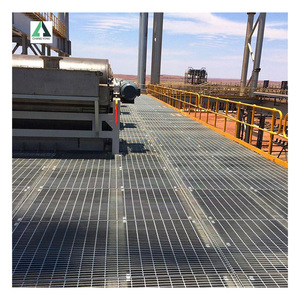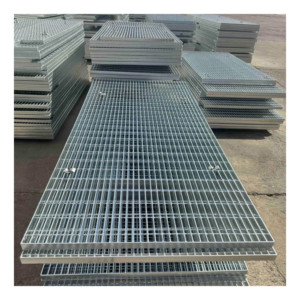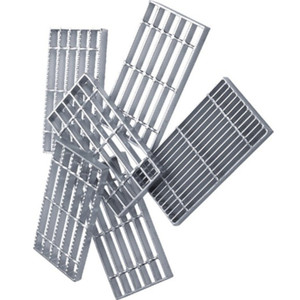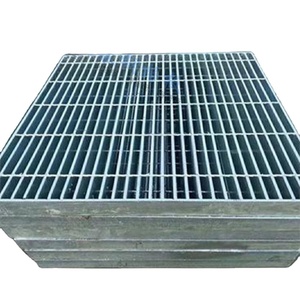(11807 products available)






























































































































































































































Walkway steel grating is a type of flooring with a latticework design made of parallel and perpendicular bars. The grating is made of steel and is used in flooring, covering a large area where people need to walk. Below are the types of steel grating:
This steel grating is designed for people to walk on and has a unique design. It is made with pressure-locked crossbars and bearing bars. The bars are put together with hydraulic pressure, which locks them in place. Because they are locked, it is stable and won't move when people walk on it. It can be used in places with a lot of foot traffic.
Like the press-locked steel grating, this type is also used for walking and is very strong. It is made with rivets that connect perpendicular bars and bearing bars. The rivets make the grating very stable and able to hold heavy things. This type of grating is used in areas where many people walk, and it needs to be very strong. It is also used in factories and water treatment plants.
This type of floor grating is made by welding crossbars and bearing bars. It is made by melting steel bars together with heat. The heat makes the steel bars join together to form the grating. The grating is very strong and can be used in areas where many people walk. It is resistant to rust and can last for a long time.
This type of steel grating is made by swaging crossbars into the bearing bars. It is made by putting pressure on the crossbars to fit them in the bearing bars. This makes a strong and safe grating that can be used in areas with many walkers. It is used in places where safety is important.
Walkway steel grating is a floor made of steel grates that are extensively used in industrial flooring, platforms, catwalks, and other areas where a solid, slip-resistant surface is required. Here are some of the main features of steel grates:
The first and most important benefit of steel grates is their strength. Steel is a strong material and can withstand heavy loads and impacts without bending, breaking, or deforming. This makes steel grates suitable for areas with high foot traffic or heavy machinery.
Another benefit of steel grates is their ability to resist corrosion. Thanks to their coatings, they can withstand harsh weather elements, chemicals, and other corrosive substances. This makes them ideal for outdoor and industrial environments.
Steel grates have an open grid design. This design offers excellent traction even in wet or oily conditions. They provide a safe walking surface to prevent accidents and injuries. Moreover, the slip resistance feature makes them suitable for areas that are often wet or greasy.
Steel grates require minimal maintenance. They are easy to clean and only need occasional sweeping and hosing to remove dirt and debris. This feature saves time and money in the long run.
Steel grates can last for decades without losing performance. Their durability and low maintenance requirements make them a cost-effective flooring solution. They have a long lifespan and can withstand various environmental factors without rusting or deteriorating.
Steel grates are versatile and can be used in many different applications. They are commonly used in industrial settings, but they are also used in commercial and residential areas. For example, metal walkways gratings can be used as decorative grilles, drain covers, and sunscreens.
Steel grates are lightweight and prefabricated. This makes them easy to install. They can be installed quickly over existing surfaces, saving time and money during construction projects.
Steel grates are made from natural materials that can be recycled at the end of their lifespan. This makes them an environmentally friendly choice compared to other flooring materials. Steel grates are recyclable, reducing the impact on the environment.
Walkway steel grating is widely used in various industries and environments. Below are some common application scenarios:
Metal grate walkways are commonly found in industrial settings such as manufacturing plants, refineries, and warehouses. They provide safe and stable platforms for workers to access equipment, machinery, and storage areas. The grating's strength and durability make it ideal for heavy foot traffic in these environments.
Steel grating walkways are used in commercial buildings like offices, shopping malls, and airports. They offer pedestrians safe and well-structured walkways.
Steel grating walkways are often used on construction sites to create temporary pathways for workers and visitors. These walkways offer safe access across uneven or hazardous terrain. Additionally, they are easily installed, removed, and repositioned as needed.
Platforms in the offshore and onshore oil and gas industry are made from steel grating. The grating provides safe access for workers in challenging environments.
Steel grating is used on docks, piers, and ships to create stable walkways for pedestrians and personnel. Its resistance to corrosion makes it ideal for marine environments. Additionally, the grating offers enhanced traction, which is essential in wet conditions.
Expanded metal walkway is often used in power plants to create elevated walkways and platforms for maintenance and operation. The grating allows for airflow and drainage, reducing the risk of slips and falls.
Steel grating walkways can be used in agricultural settings like barns, silos, and feedlots. They provide stable platforms for workers and livestock. Additionally, they allow for easy cleaning and maintenance.
Steel grating is used in telecommunication towers and equipment shelters to create secure walkways and access platforms for maintenance and operation. The grating reduces the risk of accidents.
Steel grating walkways are used in water treatment facilities to create safe and stable platforms for workers to monitor and maintain equipment. They are resistant to corrosion from water and chemicals.
When selecting steel grating for sale, it is important to consider the following factors:
Walking paths and walkways require walkway steel grating with a smooth surface to prevent slipping. The grating bars' spaces should allow light, air, and water to pass through. The grating can be welded or press-locked. Welded grating is the best choice for platforms, walkways, and stair treads. The grating can be galvanized, painted, or coated. Galvanized grating is the most durable option for wet and corrosive environments.
Grating panels are available with different bearing bar sizes and spacings. The right choice depends on the loads the grating will bear. Grating with closer bar spacings and taller bars can support heavier loads. The load requirements should be considered when choosing grating types. Press-locked and riveted grating can support heavier loads than swaged grating.
It is important to choose safety features that help prevent accidents. These can include nosings, handrails, and kick plates. Anti-skid coatings or serrated surfaces can also be added to the grating.
The environmental conditions can impact the grating type and finish. For example, galvanized grating is the best option for high-humidity environments. It can resist rust and corrosion. Stainless steel grating is also a good choice for environments with water and chemicals. It has good resistance to corrosion and rust.
It is important to consider the grating material and how it is installed. Some grating types are easy to install with clips. Panels can also be cut to size. This makes installation easier and faster. Press-locked grating is a good option for projects that need quick installation. It can be installed without welding. This saves time and money.
Q1: Does the material used in making steel grating impact the durability of the grating?
A1: Yes, the material used to make the steel grating affects its durability. Stainless steel is the most durable steel grating material because it is resistant to corrosion, abrasion, and impact. However, aluminum is less durable than stainless steel but more durable than carbon steel.
Q2: Are steel gratings safe for use in commercial and industrial spaces?
A2: Yes, steel gratings are safe for use in industrial and commercial spaces. They offer high slip resistance, which makes them safe for use in wet and oily environments.
Q3: Do steel gratings require special maintenance?
A3: Steel gratings do not require special maintenance. However, it is important to clean and inspect them regularly. If the steel grating is corroded, it should be repaired immediately to prevent further damage.
Q4: Are steel gratings customizable?
A4: Yes, steel gratings are customizable. Manufacturers can customize a steel grating to meet specific load, size, and design requirements.
Q5: What are the key differences between pressure-locked, swage-locked, and riveted steel gratings?
A5: Pressure-locked steel gratings have a clean and modern look. Swage-locked steel gratings are more rigid and can handle heavier loads. Riveted steel gratings are traditional and have a high aesthetic value. However, they require more maintenance than swage-locked and pressure-locked steel gratings.